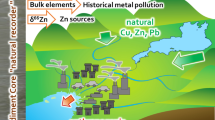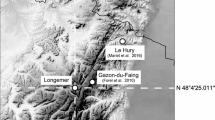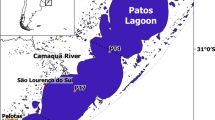Abstract
High resolution geochemical (Itrax micro-XRF and wavelength dispersive XRF) data, radiochronology (210Pb and 137Cs analyses) and ultra-high precision double-spike lead isotope measurements from lacustrine sediment cores are used in combination with historical research of former mining landscapes to investigate modern pollution signals in sediments from Windermere, the largest lake in the English Lake District. The sediment record suggests that while most element concentrations have been stable, there has been a significant increase since the 1930s in lead, zinc and copper concentrations. Double-spike lead isotope measurements reveal a mixture of natural lead, and three major contributory sources of anthropogenic (industrial) lead, comprising gasoline lead, coal combustion lead (from coal-fired steam ships) and lead derived from Carboniferous Pb–Zn mineralisation (mining activities). A number of up-system sediment traps have limited the amount of mining related heavy metals entering Windermere, and as a result, periods of metal workings do not correlate with peaks in heavy metals. Increases could also be due to flood-induced metal inwash or weathering of bedrock in the catchment. Application of these non-destructive and high precision analytical techniques provides new insights into the pollutant depositional history of Windermere.
Access this chapter
Tax calculation will be finalised at checkout
Purchases are for personal use only
Similar content being viewed by others
References
Adams J (1988) Mines of the Lake District fells. Dalesman Books, Clapham
Adams J (1995) Mines of the Lake District fells, 2nd edn. Dalesman Publishing Company, Clapham
Anderton J, Haworth EY, Horne DJ, Wray DS (1998) Environmental impacts of lead mining in the Ullswater catchment (English Lake District): dam failures and flooding. In: Bennett MR, Doyle P (eds) Issues in environmental geology: a British perspective. The Geological Society, London, pp 226–242
Appleby P (2008) Three decades of dating recent sediments by fallout radionuclides: a review. Holocene 18:83–93
Appleby P, Richardson N, Nolan P (1991) 241Am dating of lake sediments. Hydrobiologia 214:35–42
Appleby PG, Haworth EY, Michel H, Short DB, Laptev G, Piliposian, GT (2003) The transport and mass balance of fallout radionuclides in Blelham Tarn, Cumbria (UK). J Paleolimnol 29:459–473
Aston SR, Bruty D, Chester R, Padgham RC (1973) Mercury in lake sediments: a possible indicator of technological growth. Nature 241:450–451
Barker PA, Pates JM, Payne RJ, Healey R. M (2005) Changing nutrient levels in Grasmere, English Lake District, during recent centuries. Freshw Biol 50:1971–1981
Barlow D, Harris E, McFarlane A (2009a) Windermere fluvial audit. Report A: catchment scale geomorphology—technical report. Report to Environment Agency North West Region prepared by JACOBS Engineering UK Ltd. Technical Report
Barlow D, Harris E, McFarlane A (2009b) Windermere fluvial audit. Report B: catchment action plan. Report to Environment Agency North West Region prepared by JACOBS Engineering UK Ltd. Technical Report
Blundell DJ (1994) Greenburn or great Coniston copper mine Little Langdale. A collected history. In: Borthwick D (ed) The mine explorer, vol 4. Cumbria Amenity Trust Mining History Society, pp 76–80. www.catmhs.org.uk
British Geological Survey (1992) Regional geochemistry of the Lake District and adjacent areas
British Geological Survey (1996) Ambleside. England and Wales Sheet 38. Solid geology, vol 1. Keyworth, Nottingham, pp 50000
British Geological Survey (2000) Geology of the Ambleside district. The Stationary Office, London
Cameron DG, Idoin NE, Brown TJ, Patton MAG, McGinn C, Mankelow JM (2010) Directory of mines and quarries. British geological survey, 9th edn. Keyworth, Nottingham
Chiverrell RC, Sear D, Dearing J, Warburton J, Schillereff D, Croudace IW (2012) Farming, mining and extreme floods: impacts of accelerated sediment flux to Bassenthwaite Lake, International Palaeolimnology Conference (IPS2012), August 21–24th, Glasgow SECC.
Chow TJ, Snyder CB, Earl JL (1975) Isotope ratios of lead as pollutant source indicators. In: Isotope ratios as pollutant source and behaviour indicators. IAEA, Vienna, pp 95–108
Croudace IW, Cundy AB (1995) Heavy metal and hydrocarbon pollution in recent sediments from Southampton water, Southern England: a geochemical and isotopic study. Environ Sci Technol 29:1288–1296
Croudace IW, Williams-Thorpe O (1988) A low dilution, wavelength-dispersive x-ray fluorescence procedure for the analysis of archaeological rock artefacts. Archaeometry 30:227–236
Croudace IW, Rindby A, Rothwell RG (2006) ITRAX: description and evaluation of a new multi-function X-ray core scanner. Rothwell R (ed) New techniques in sediment core analysis, vol 267. Geological Society Special Publication, pp 51–63
Croudace IW, Warwick PE, Morris JE (2012) Evidence for the preservation of technogenic tritiated organic compounds in an estuarine sedimentary environment. Environ Sci Technol 46:5704–5712
Dowman I, Balan P, Renner K, Fischer P (2003) An evaluation of Nextmap terrain data in the context of UK national datasets. Technical Report
Eastwood T (1921) Memoirs of the geological survey. Special reports on the mineral resources of Great Britain: the lead and zinc ores of the Lake District, vol 22
Farmer JG, Eades LJ, Mackenzie AB, Kirika A, Bailey-Watts TE (1996) Stable lead isotope record of lead pollution in Loch Lomond sediments since 1630 A.D. Environ Sci Technol 30:3080–3083
Farmer JG, Eades LJ, Graham MC (1999) The lead content and isotopic composition of British coals and their implications for past and present releases of lead to the UK environment. Environ Geochem Health 21:257–272
Flynn WW (1968) Determination of low levels of polonium-210 in environmental materials. Anal Chim Acta 43:221–227
Grayson RP, Plater AJ (2009) A lake sediment record of Pb mining from Ullswater, English Lake District, UK. J Paleolimnol 42:183–197
Gulson BL, Mizon KJ, Law AJ, Korsch MJ, Davis JJ, Howarth D (1994) Source and pathways of lead in humans from the broken hill mining community; an alternative use of exploration methods. Econ Geol 89:889–908
Hamilton-Taylor J (1979) Enrichments of zinc, lead, and copper in recent sediments of Windermere, England. Environ Sci Technol 13:693–697
Hamilton-Taylor J (1983) Heavy metal enrichments in the recent sediments of six lakes in northwest England. Environ Technol Lett 4:115–122
Hamilton EI, Clifton RJ (1979) Isotopic abundances of lead in estuarine sediments, Swansea Bay, Bristol Channel. Estuar Coast Mar Sci 8:271–278
Hansmann W, Köppel V (2000) Lead-isotopes as tracers of pollutants in soils. Chem Geol 171:123–144
Hart SR (1984) A large-scale isotope anomaly in the Southern Hemisphere mantle. Nature 309:753–757
Hatfield RG, Maher BA, Pates JM, Barker PA (2008) Sediment dynamics in an upland temperate catchment: changing sediment sources, rates and deposition. J Paleolimnol 40:1143–1158
Ishizuka O, Taylor RN, Milton JA, Nesbitt RW (2003) Fluid-mantle interaction in an intra-oceanic arc: constraints from high-precision Pb isotopes. Earth Planet Sci Lett 211:221–236
Johnson CC, Breward N, Ander EL, Ault L (2005) G-BASE: baseline geochemical map** of Great Britain and Northern Ireland. Geochem Explor Environ Anal 5:347–357
Kelly M (1991) Mining and the freshwater environment. Elsevier Applied Science, London
Kember HM (2001) A study of metal contamination of sediments within Lake Ullswater and the Glenridding Beck catchment. Undergraduate Dissertation, Department of Environmental Science, University of Lancaster
Komárek M, Ettler V, Chrastný V, Mihaljevic M (2008) Lead isotopes in environmental sciences: a review. Environ Int 34:562–577
McGowan S, Barker P, Haworth EY, Leavitt PR, Maberly SC, Pates J (2012) Humans and climate as drivers of algal community change in Windermere since 1850. Freshw Biol 57:260–277
Miller H, Bull JM, Cotterill JC, Dix JK, Winfield IJ, Kemp AES, Pearce RB (2013) Lake bed geomorphology and sedimentary processes in glacial lake Windermere, UK. J Maps 9:299–312
Miller H, Croudace IW, Bull JM, Cotterill JC, Dix JK, Taylor RN (2014) A 500 year sediment lake record of anthropogenic and natural inputs to Windermere (English Lake District) using double-spike lead isotopes, radiochronology, and sediment microanalysis. Environ Sci Technol 48:7254–7263
Millward R, Robinson A (1974) The regions of Britain. Eyre Methuen, The Lake District
Millward D, Johnson EW, Beddoe-Stephens B, Young B, Kneller BC, Lee MK, Fortey NJ (2000) British geological survey: geology of the Ambleside district. Memoir for 1:50,000 Geological Sheet 38 (England and Wales). The Stationary Office, London
Mitchell GH (1956) The geological history of the Lake District. Proc Yorks Geol Soc 30:407–463
Monna F, Lancelot J, Croudace IW, Cundy AB, Lewis JT (1997) Pb isotopic composition of airborne particulate material from France and the southern United Kingdom: implications for Pb pollution sources in urban areas. Environ Sci Technol 31:2277–2286
Parker JE, Maberly SC (2000) Biological response to lake remediation by phosphate strip**: control of Cladophora. Freshw Biol 44:303–309
Pattinson GH (1981) The great age of steam on Windermere. The Windermere Nautical Trust
Pennington W, Cambray RS, Fisher EM (1973) Observations on lake sediments using fallout 137Cs as a tracer. Nature 242:324–326
Pennington W, Cambray RS, Eakins JD, Harkness DD (1976) Radionuclide dating of the recent sediments of Blelham Tarn. Freshw Biol 6:317–331
Pickering AD (2001) Windermere: restoring the health of England’s largest lake. Freshwater Biological Association, Ambleside Special Publication No. 11
Pinson LJW, Vardy ME, Dix JK, Henstock TJ, Bull JM, Maclachlan SE (2013) Deglacial history of glacial lake Windermere, UK: implications for the central British and Irish Ice Sheet. J Quat Sci 28:83–94
Postlethwaite J (1975) Postlethwaite’s mines and mining in the English Lake District. Michael Moon, Beckermet
Reynolds CS, Irish AE (2000) The phytoplankton of Windermere (English Lake District). Freshwater Biological Association, Ambleside
Ritchie JC, McHenry JR (1990) Application of radioactive fallout cesium-137 for measuring soil erosion and sediment accumulation rates and patterns: a review. J Environ Qual 19:215–233
Robbins JA (1978) Geochemical and geophysical applications of radioactive lead isotopes. In: Nriagu JO (ed) Biochemistry of lead. Elsevier, Amsterdam, pp 285–393
Sabater S, Haworth EY (1995) An assessment of recent trophic changes in Windermere South Basin (England) based on diatom remains and fossil pigments. J Paleolimnol 14:151–163
Schillereff D, Chiverrell R, Macdonald N, Hooke J (2013) A multi-proxy lake sediment record of recent anthropogenic influence on catchment processes from Brotherswater, northwest England. Oral presentation at European Geosciences Union General Assembly 2013, 7–12 April 2013, Vienna, Austria. Session: landscape in the Anthropocene: state of the art and future directions
Shaw WT (1939) Elizabethan Mining: an account of a visit paid to an old lead mine near Grasmere, Lake District
Shaw WT (1970) Mining in the Lake Counties. Dalesman, Clapham
Shepherd TJ, Chenery SR, Pashley V, Lord RA, Ander LE, Breward N, Hobbs SF, Horstwood M, Klinck BA, Worrall F (2009) Regional lead isotope study of a polluted river catchment: River Wear, Northern England, UK. Sci Total Environ 407:4882–4893
Talling JF (1999) Some English lakes as diverse and active ecosystems: a factual summary and source book. Freshwater Biological Association, Far Sawrey
Taylor RN, Ishizuka O, Michalik A, Milton JA, Croudace IW (2015) Evaluating the precision of Pb isotope measurement by mass spectrometry. J Anal Atomic Spectrom 30(1):198–213
Tyler I (2005) Thirlmere mines and the drowning of the valley. Blue Rock Publications, Cumbria
Tyler I (2006) The lakes and Cumbria mines guide. Blue Rock Publications, Cumbria
Yang HD, Rose N (2005) Trace element pollution records in some UK lake sediments, their history, influence factors and regional differences. Environ Int 31:63–75
Yang HD, Rose NL, Battarbee RW, Boyle JF (2002) Mercury and lead budgets for Lochnagar, a Scottish mountain lake and its catchment. Environ Sci Technol 36(7–8):1383–1388
Williams T (1991) A sedimentary record of the deposition of heavy metals and magnetic oxides in the Loch Dee basin, Galloway, Scotland, since c. AD 1500. Holocene 1:142–150
Woodcock NH, Soper NJ (2006) The Acadian orogeny: the mid-Devonian phase of deformation that formed slate belts in England and Wales. In: Benchley PJ, Rawson F (eds) The geology of England and Wales, 2nd edn. The Geological Society, London
Woodhead JD, Volker F, McCulloch MT (1995) Routine lead-isotope determinations using a Pb-207 Pb-204 double spike—a long-term assessment of analytical precision and accuracy. Analyst 120:35–39
Author information
Authors and Affiliations
Editor information
Editors and Affiliations
Rights and permissions
Copyright information
© 2015 Springer Science+Business Media Dordrecht
About this chapter
Cite this chapter
Miller, H., Croudace, I., Bull, J., Cotterill, C., Dix, J., Taylor, R. (2015). Modern Pollution Signals in Sediments from Windermere, NW England, Determined by Micro-XRF and Lead Isotope Analysis. In: Croudace, I., Rothwell, R. (eds) Micro-XRF Studies of Sediment Cores. Developments in Paleoenvironmental Research, vol 17. Springer, Dordrecht. https://doi.org/10.1007/978-94-017-9849-5_16
Download citation
DOI: https://doi.org/10.1007/978-94-017-9849-5_16
Published:
Publisher Name: Springer, Dordrecht
Print ISBN: 978-94-017-9848-8
Online ISBN: 978-94-017-9849-5
eBook Packages: Earth and Environmental ScienceEarth and Environmental Science (R0)




